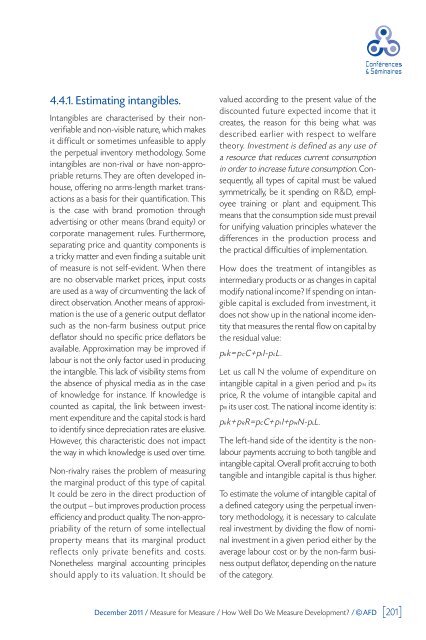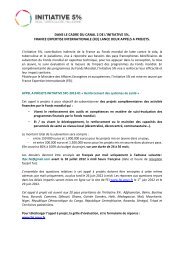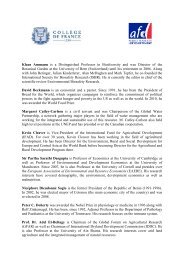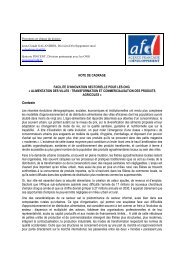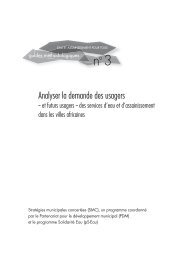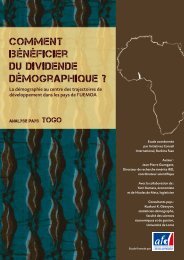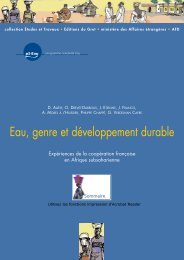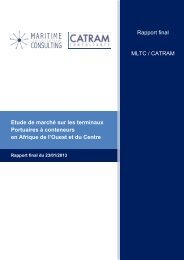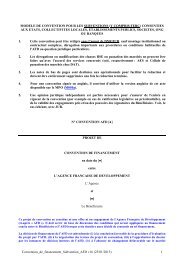Paris School of Economics - L'Agence Française de Développement
Paris School of Economics - L'Agence Française de Développement
Paris School of Economics - L'Agence Française de Développement
You also want an ePaper? Increase the reach of your titles
YUMPU automatically turns print PDFs into web optimized ePapers that Google loves.
4.4.1. Estimating intangibles.<br />
Intangibles are characterised by their nonverifiable<br />
and non-visible nature, which makes<br />
it difficult or sometimes unfeasible to apply<br />
the perpetual inventory methodology. Some<br />
intangibles are non-rival or have non-appropriable<br />
returns. They are <strong>of</strong>ten <strong>de</strong>veloped inhouse,<br />
<strong>of</strong>fering no arms-length market transactions<br />
as a basis for their quantification. This<br />
is the case with brand promotion through<br />
advertising or other means (brand equity) or<br />
corporate management rules. Furthermore,<br />
separating price and quantity components is<br />
a tricky matter and even finding a suitable unit<br />
<strong>of</strong> measure is not self-evi<strong>de</strong>nt. When there<br />
are no observable market prices, input costs<br />
are used as a way <strong>of</strong> circumventing the lack <strong>of</strong><br />
direct observation. Another means <strong>of</strong> approximation<br />
is the use <strong>of</strong> a generic output <strong>de</strong>flator<br />
such as the non-farm business output price<br />
<strong>de</strong>flator should no specific price <strong>de</strong>flators be<br />
available. Approximation may be improved if<br />
labour is not the only factor used in producing<br />
the intangible. This lack <strong>of</strong> visibility stems from<br />
the absence <strong>of</strong> physical media as in the case<br />
<strong>of</strong> knowledge for instance. If knowledge is<br />
counted as capital, the link between investment<br />
expenditure and the capital stock is hard<br />
to i<strong>de</strong>ntify since <strong>de</strong>preciation rates are elusive.<br />
However, this characteristic does not impact<br />
the way in which knowledge is used over time.<br />
Non-rivalry raises the problem <strong>of</strong> measuring<br />
the marginal product <strong>of</strong> this type <strong>of</strong> capital.<br />
It could be zero in the direct production <strong>of</strong><br />
the output — but improves production process<br />
efficiency and product quality. The non-appropriability<br />
<strong>of</strong> the return <strong>of</strong> some intellectual<br />
property means that its marginal product<br />
reflects only private benefits and costs.<br />
Nonetheless marginal accounting principles<br />
should apply to its valuation. It should be<br />
valued according to the present value <strong>of</strong> the<br />
discounted future expected income that it<br />
creates, the reason for this being what was<br />
<strong>de</strong>scribed earlier with respect to welfare<br />
theory. Investment is <strong>de</strong>fined as any use <strong>of</strong><br />
a resource that reduces current consumption<br />
in or<strong>de</strong>r to increase future consumption. Consequently,<br />
all types <strong>of</strong> capital must be valued<br />
symmetrically, be it spending on R&D, employee<br />
training or plant and equipment. This<br />
means that the consumption si<strong>de</strong> must prevail<br />
for unifying valuation principles whatever the<br />
differences in the production process and<br />
the practical difficulties <strong>of</strong> implementation.<br />
How does the treatment <strong>of</strong> intangibles as<br />
intermediary products or as changes in capital<br />
modify national income? If spending on intangible<br />
capital is exclu<strong>de</strong>d from investment, it<br />
does not show up in the national income i<strong>de</strong>ntity<br />
that measures the rental flow on capital by<br />
the residual value:<br />
pkk=pCC+pI I-pLL .<br />
Let us call N the volume <strong>of</strong> expenditure on<br />
intangible capital in a given period and p N its<br />
price, R the volume <strong>of</strong> intangible capital and<br />
p R its user cost. The national income i<strong>de</strong>ntity is:<br />
pkk+pRR=pCC+ p I I+pNN-pLL.<br />
The left-hand si<strong>de</strong> <strong>of</strong> the i<strong>de</strong>ntity is the nonlabour<br />
payments accruing to both tangible and<br />
intangible capital. Overall pr<strong>of</strong>it accruing to both<br />
tangible and intangible capital is thus higher.<br />
To estimate the volume <strong>of</strong> intangible capital <strong>of</strong><br />
a <strong>de</strong>fined category using the perpetual inventory<br />
methodology, it is necessary to calculate<br />
real investment by dividing the flow <strong>of</strong> nominal<br />
investment in a given period either by the<br />
average labour cost or by the non-farm business<br />
output <strong>de</strong>flator, <strong>de</strong>pending on the nature<br />
<strong>of</strong> the category.<br />
December 2011 / Measure for Measure / How Well Do We Measure Development? / © AFD [ 201]


